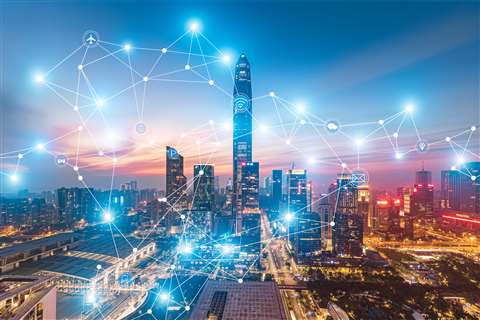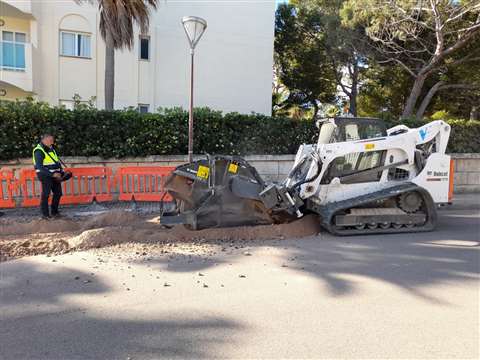How will 5G impact construction?
29 July 2022
The fifth generation of wireless technology, seen by some as the last piece in the connectivity puzzle, is on the horizon. Tom Jackson investigates what impact it could have.
The most significant advancement in construction technology in the last two decades is now visible on the horizon and promises to provide previously unimaginable levels of connectivity and productivity.
 5G will provide a quantum leap forward in cellular communications. (Photo: Adobe Stock)
5G will provide a quantum leap forward in cellular communications. (Photo: Adobe Stock)
5G, the fifth generation of wireless technology, is said by some to be the last piece of the puzzle OEMs and technology companies have wanted for years. Manufacturers are keeping quiet about their plans, but when those applications and machines emerge it will change everything.
Today’s technology can connect the field and the shop with the office and drive autonomous machines, remote control, and some artificial intelligence, says Aviad Almagor, vice president of technology innovation at Trimble. But to fulfil this vision – to control a large number of IoT (Internet of Things) devices and get fully functional, real-time augmented reality and mixed reality on the jobsite – the industry needs the low latency and higher bandwidths that only 5G can provide, he says.
Many of today’s data acquisition processes, such as point clouds, images, or simultaneous localisation and mapping data are already run on cloud-based solutions and near real-time processing, says Ulrich Hermanski, CMO and executive vice president at Topcon Positioning Group. The data rates anticipated with 5G networks will open completely new perspectives on this, especially for building construction, he says.
5G will also take much of the computer processing that happens on your tablet, laptop or phone and move it to the cloud, says Joe Mosele, vice president mobility, IoT and 5G for AT&T Industry Solutions in the US. The cloud is a much bigger, more powerful and versatile computer than anything you can hold in your hand – this will lower the cost of all these devices, and drastically cut the battery drain and weight.
 Erik Varney, managing director of industrial IoT at Verizon. (Photo: Verizon)
Erik Varney, managing director of industrial IoT at Verizon. (Photo: Verizon)
“That’s going to give them more control to run their locations than they ever had in the past,” says Mosele. “It’s going to allow them to provide a network that they control that could cover both indoor and outdoor locations, something that they probably can’t get with a traditional Wi-Fi. The cost of a network to deploy robots will likely be lower as will the onboard computer needs for machines and devices,” he says.
“In this industry it’s all about connectivity,” says Erik Varney, managing director of industrial IoT at Verizon. “It used to be small and medium businesses didn’t need connectivity but they’re finding more frequently that you have to have it just to do standard day-to-day operations.”
How does 5G work?
In 4G LTE networks, the lag time between a signal being sent and received is about 90 milliseconds. The current target for 5G latency is ten milliseconds or less depending on the provider, says Burcin Kaplanoglu, vice president of Oracle Industry Labs.
 Burcin Kaplanoglu, vice president of Oracle Industry Labs. (Photo: Oracle Industry Labs)
Burcin Kaplanoglu, vice president of Oracle Industry Labs. (Photo: Oracle Industry Labs)
“When you’re trying to control equipment remotely, you do not want any lag time,” he says. “You want to have the best control you can. It can be done on a 4G network today. But the lower the latency, the better your response time.”
With the lower latency and all the sensors and data that 5G can pour into a simulator application, the seat-of-the-pants feel on a simulator can be made as real as it is in the field, says Varney. If your remote dozer in the field hits a boulder, the simulator will lurch as hard as the machine in the field. This kind of feedback will make remote operators much more efficient, careful, accurate, and safe, and help prevent machine damage.
5G is vital for the advanced development of robotics and autonomous machines says Anders Candell, senior vice president at Skanska Group. These technologies require stable, high bandwidth for equipment steering, real time monitoring and digital workflows. “We will be able to understand the situation at a site to a greater extent and hence be able to optimise planning and avoid hazardous situations,” he says.
 Anders Candell, senior vice president at Skanska Group. (Photo: Skanska Group)
Anders Candell, senior vice president at Skanska Group. (Photo: Skanska Group)
“A lot is happening in robotics, autonomous scanners, autonomous drones, and autonomous equipment,” says Kaplanoglu. “If you’re doing autonomous operations, latency becomes important. You have to be able to communicate backwards and forwards to do that. You can’t have autonomy if you have connectivity issues.”
Ulrich Hermanski, Executive Vice President, General Manager Positioning Solutions, at Topcon comments that, “5G will bring decisive steps forward in civil engineering, where our customers rely on construction site management systems in which all construction machines and the office communicate with each other in real-time.
“Real-time data transfer from machines to supervisors will aid productivity and decision-making.”
5G’s promise is to have a million sensors communicating per square kilometre, says Kaplanoglu.
Sensors plus computer vision cameras will likely be combined to improve jobsite safety and prevent collisions and accidents.
With the cloud computing enabled by 5G, the sensors will even be able to project trajectories and warn workers of potential problems ahead of time. Sensors will also be embedded in buildings, highways, bridges, and other built structures to monitor conditions, wear, and things like earthquakes and natural disasters.
Sensors and cameras will also allow inspectors to view progress on a job and certify completions and code compliance without having to leave their office and avoid these all-too common delays that plague construction today. The kind of remote monitoring that sensors and cameras provide will also break down the silos and the inefficiencies that arise between the different trades and the general contractor.
 Ulrich Hermanski, CMO and executive vice president at Topcon Positioning Group. (Photo: Topcon Positioning Group)
Ulrich Hermanski, CMO and executive vice president at Topcon Positioning Group. (Photo: Topcon Positioning Group)
How can augmented and virtual reality be used in construction?
Today, augmented reality or virtual reality devices contain a small internal computer. When 5G moves that computing power to the cloud, the weight and cost of the headset will decrease, and the capabilities increase. “When you are carrying your computer around with you there are data limitations, storage limitations, and processing limitations,” says Kaplanoglu.
But when you eliminate the computing element in the hardware, the possibility for devices is almost unlimited. Currently AR and VR headsets cost about US$3,000. Cloud connected, 5G enabled headsets may only cost US$30, says Kaplanoglu. Expect to see a proliferation of these and other AR and VR devices used in everything from equipment repair to earthmoving, layouts, troubleshooting and training.
 Martin Lorenzen, head of gateways and telematics, Liebherr-Elektronik. (Photo: Liebherr-Elektronik)
Martin Lorenzen, head of gateways and telematics, Liebherr-Elektronik. (Photo: Liebherr-Elektronik)
With cameras, sensors, laser scanners and 5G, specialised skill sets and experts in engineering disciplines will be able to supervise work and troubleshoot problems from 100m or half a world away.
For example, say the installation of high-tension cables on a bridge project is running into some problems. Today you might have to pay an engineer to drive or fly to a site, diagnose the problem, and walk your crews through the solution, pay the attendant costs, and deal with the delays. With 5G enabled technology, the problem may be solved by the expert who can see the issues and communicate with crews in the field without ever leaving their house, says Kaplanoglu.
Telecoms are hard at work rolling out 5G systems across the globe. Many urban areas will have them within the next year with rural or remote areas to follow. China has taken the lead here, but the US and Europe are moving quickly as well.
Commercially available 5G machines, however, have yet to hit the marketplace. OEMs and manufacturers are developing these but keeping their plans under wraps for now. More than likely, the 5G systems will be backward compatible with 4G and LTE, but 5G enabled systems will be required to take advantage of the new capabilities.
Fortunately for owners of today’s equipment, there is no end date to 4G LTE. Machines with 4G LTE based telematics will still be able to send and receive information so long as an LTE network is available, and telecoms providers say they will keep those up and running for years to come.
 Aviad Almagor, vice president of technology innovation, Trimble. (Photo: Trimble)
Aviad Almagor, vice president of technology innovation, Trimble. (Photo: Trimble)
How big a difference is there between 4G and 5G?
While the roll out of 5G will go on for several years, in areas where it is not available there are workarounds. These configurations function in a similar way to local area networks (LANS) but with the benefits of 5G.
Unlike the previous 4G standard, 5G makes it possible to set up so-called campus networks, says Martin Lorenzen, head of gateways and telematics at Liebherr-Elektronik.
“They are ideal for motorway construction sites that extend over several kilometres and cannot be covered with Wi-Fi,” says Lorenzen. “They are also suitable for use in mining, where the work sites are often far away from today’s mobile phone networks. Our customers are already benefiting from IoT gateways that enable machine-to-machine communications,” he says.Topcon is involved in a development project to implement a local private 5G system, says Hermanski.
“Currently, these private 5G networks are limited to large factory and processing plant locations. In the future, we expect more private 5G networks to be established in mining locations or for a temporary setup for the construction period if there is no existing coverage,” he says.
In the developing world 5G enabled autonomous equipment operation will give these regions the benefit of building infrastructure using expert operators and advanced machine control techniques from halfway around the globe. This will reduce the cost of building, troubleshooting, and maintaining infrastructure in less developed countries, and enable contractors from the developed world to complete more of these types of jobs while deploying fewer people.
While 5G is still on the cusp of becoming a commercial reality, there are a lot of things contactors can do to position themselves to be ready take advantage of it when it does arrive. For starters, Kaplanoglu recommends making use of currently available camera systems and sensors to monitor and improve jobsite safety.
 Bobcat has a remote control system for compact loaders – 5G could see the popularity of remote controlled equipment increasing. (Photo: Bobcat)
Bobcat has a remote control system for compact loaders – 5G could see the popularity of remote controlled equipment increasing. (Photo: Bobcat)
“I wouldn’t advise anybody to delay a purchase if they’re waiting on 5G to become available,” adds Mosele. “LTE technology is capable of doing most of what they need. But when 5G becomes available, they should probably make that choice. It’s a valid question to ask your machine dealer.”
Verizon’s Varney recommends the ‘crawl–walk–run,’ approach. “Look at the basics, something that might save you ten hours a week,” he says. “Get some experts to walk you through some of the current solutions with a future opportunity. Then you’ll have that relationship to build on in the future.”
“The first thing they need to do is to set a vision, where are they now, where they want to be five years from now,” says Almagor. “What are the technologies that will help them achieve this? Is it autonomous, AI, machine learning? Is it anything else 5G can enable?”
Once you have that vision, start planning backward, says Almagor. “What is already available? What are the sensors and tools I need? How will 5G play into this vision? It’s easier at the moment to start with a private 5G network because you have control and you can pick your specific project, set up the system and start deploying.”
How fast is 5G?
In theory 5G will deliver 20 gigabytes per second at peak speed, 20 times more data than 4G LTE. And 4G LTE is also limited in bandwidth, operating up to 6 GHz (gigahertz), whereas 5G can operate from 30 to 300 GHz. The wider bandwidth means less crowding on the airwaves so fewer slowdowns and lower latency, which is the time between when a packet of information is sent and when it is received.
One of the terms that you hear regarding 5G is “ultra-reliable,” says Joe Mosele, vice president mobility, IoT and 5G for AT&T Industry Solutions in the US. “Low latency is going to give you more granular control of quality of service so you can have an even more robust network for application developers to build on. 5G is going to enable them to do a lot more.”
5G will provide a quantum leap forward in cellular communications but the speeds will depend on the carrier, the 5G technology and spectrum they use. Tests run by independent technophiles in the US show a wide range of outcomes. And 5G signals cannot travel as far as 4G. All of which goes to say, do your homework first before signing up for a plan, or buying the hardware to receive 5G signals.
STAY CONNECTED



Receive the information you need when you need it through our world-leading magazines, newsletters and daily briefings.
CONNECT WITH THE TEAM







